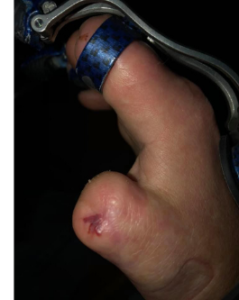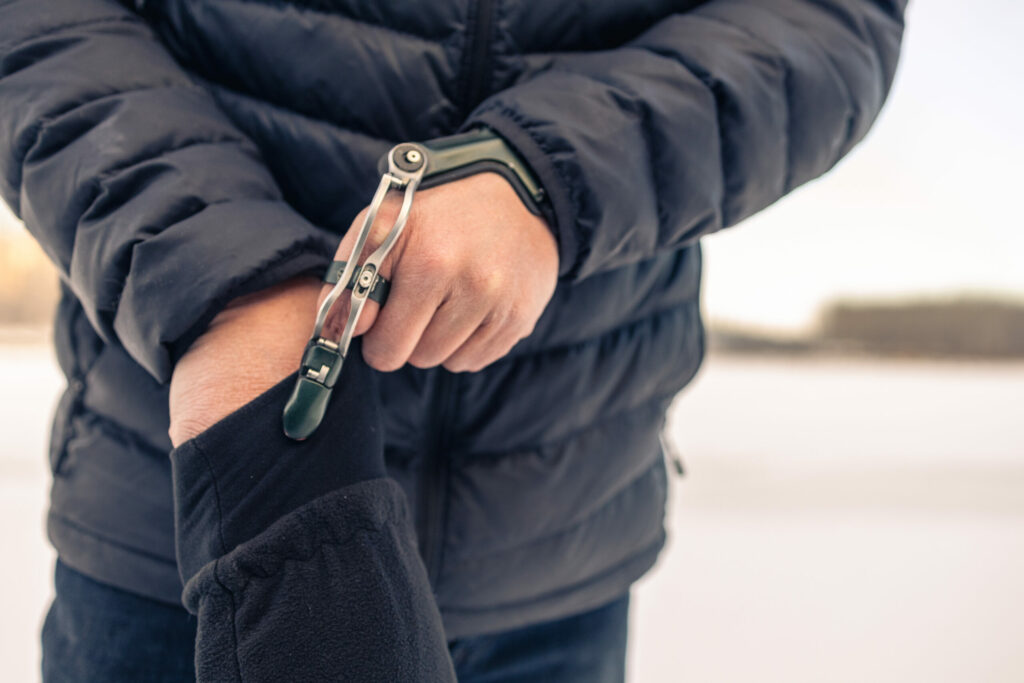We are approaching the half-way point of the season and the difficulties that come with the weather change continue to affect people’s lives, particularly the amputee community. It is very common for partial hand and finger amputees to experience extreme hypersensitivity and cold intolerance because of the high density of nerves in our hands.
While there are many resources online that center on the cold weather issue, they are not specific to partial hand and finger amputees. This conclusion inspired us to reach out to our ambassadors (Matt, Nick, and Erik) to discuss their challenges and to ask for some tips.
“This is a huge issue because I get a severe pain in my hand and arm when it’s cold out, it’s almost unbearable for me.”–Matt Finney

Matt has been wearing his device every day for almost three years, and he sees it as a true extension of himself. Taking them off instantly affects his mobility and changes the way he operates. In fact, Matt shared a story on our support group platform about an incident at work when he took off his device because he didn’t want to risk hitting it and accidentally caught the corner of his residual limb with a hammer. Our devices are crafted not only to help digital amputees regain function on their hands but also to protect them.
(The picture on the right shows Matt’s digit after the incident.)
As our research continued, we ran into other common challenges amputees face because of the adversities of the weather and compiled them with a few quick and easy suggestions from our ambassadors:
Soreness/Pain | The drop in temperature not only affects your residuum, but it’s also tough on your joints and bones.
“If it gets down to below 40 degrees, I feel the pain immediately,” says Matt. He would place hand warmers in between the layers of his gloves to manage the aches.
Nick shares the same problem—“The cold weather can cause severe, debilitating pain in my hands within seconds of exposure.” Nick tries to have access to gloves regardless of whether he plans on being outside. He also got fleece-lined leather gloves custom sewn to fit his amputation that can protect him for short periods of time. When he knows he will be outdoors for a substantial amount of time, his go-to armor is a pair of mittens combined with hand -warmer packets.
Erik lives in the Pacific Northwest and notices he handles cold, dry days better than cold, rainy days (even though the temperature is usually a smidge higher when it rains). He heavily relies on hand-warmer packets and his expedition mitts, which are big enough to contain his hand with his device on.
Dry, Cracked Skin | It’s common to experience some dryness during winter, but more so on the residuum because of the susceptibility of the skin.
Matt suggests applying some lotion on your hands and wearing a pair of latex gloves overnight to keep them moisturized.
For Nick, the pads of his thumbs suffer the most to the point that they become open wounds due to severe cracking: “I try to stay on top of it by moisturizing nightly (I have done what Matt does occasionally), but if it gets away from me, I’ll wear band aids with Neosporin on my thumbs throughout the day. I find that really helps prevent any further damage and dramatically increases healing speeds.”
Erik goes above and beyond in making sure his hands remain covered with his mittens made with Gore-Tex (a waterproof, breathable fabric) to prevent dry hands. Erik uses Aloe vera lotion to help soothe and moisturize his hands whenever the dryness and itchiness bother him.
Note: Before using any moisturizing agent, seek some advice from your prosthetist to make sure it won’t cause any irritations.
Limb Volume Fluctuations | Ambient conditions such as temperature and humidity can cause volume fluctuations. Cold weather tends to constrict blood vessels, which leads to poor circulation causing your digits to shrink.
“I do sometimes feel like my device fits slightly different, and it’s definitely related to temperature—when my hands are cold, they’ll shrink up a little. I notice a slightly looser fit of the rings, but it’s not enough to diminish function,” says Nick.
There are mornings when Matt feels his device is sitting differently, but this feeling disappears as the day goes on. Matt overcomes this issue by placing additional Velcro strips to stabilize his device whenever he notices a fitting variation. This is parallel to our logic behind engineering different size shims that can accompany our devices to properly secure them to our wearers’ digits without diminishing their comfort and functionality.
What truly surprised us is learning that shrunken blood vessels can also have the exact opposite effect when they expand too quickly, causing affected areas to swell. These fluctuations can alter how your device fits.
Here’s a general reminder from Erik, “Always think and plan ahead, make sure you have proper and adequate protection, so that the issue won’t be so dire.” Protecting your whole body by keeping it warm makes other parts of you less rigid. This can make moving around a bit easier and may even help you withstand any pain.
We hope these tips help you tackle the cold winter season! Got any suggestions or routines that you would like to share? Let us know in the comments section below!
Thank you to our ambassadors for making this blog possible. Get to know each of them by clicking their names below.

Matt Finney Nick Armstrong Erik Bjarnason
Resources:
Interview with Matt Finney, Nick Armstrong, and Erik Bjarnason
“FAQ For Partial-Hand and Finger Amputees” Amputee Coalition. March 1, 2019, Accessed Dec. 9, 2019. https://www.amputee-coalition.org/partial-hand-finger-amputation-faq/
Murphy, Douglas. “Medical Management of the residual limb” Fundamentals of Amputation Care and Prosthetics. Aug. 28, 2013, Accessed Dec. 20, 2019
Street G. Vacuum Suspension and its Effects on the Limb. Orthopadie Technik. 2006 Apr [Google Scholar]
“Atlas of Limb Prosthetics: Surgical, Prosthetic, and Rehabilitation Principles” O and P Library. 1992, Accessed Dec. 20, 2019


